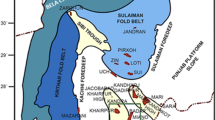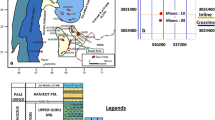Abstract
Carbonate sedimentary reservoirs are developed during a very short distance from the source rock to the reservoir formations. The reservoir formations require a seal, which can stop the migration of oil and gas-bearing reserves to stop further upward migrations. The chief aim of this study is to predict the coarse-grained, hydrocarbon-bearing, and porous stratigraphic traps inside the Lower-Eocene carbonate sequences of the Indus Basin, onshore Pakistan. The conventional seismic amplitudes are not sufficient enough to predict the exact quality of the reservoir, which has accumulated the porous reservoir facies. This study utilizes the seismic attributes and instantaneous spectral porosity simulation technologies applied to predict primary porosity for Habib Rahi Limestone (HRL) of the onshore Indus Basin, Pakistan. Exploration of stratigraphic traps is constrained to predict the porous, fractured, and thin-bedded carbonate reservoir systems. The bandlimited seismic attributes have predicted limited distribution of porous limestone facies. The 45-Hz tuning block has resolved the regionally distributed lenticular shoal limestone lens. The bandlimited porosity modelling has demonstrated extensive noise effects. Extensive processing was applied using the amplitude spectrum of 15–75 Hz on HRL for reservoir quality control. This processing has identified the ‘sweet spots’ within the complete shoal platform. The conventional porosity model showed tuning effects within the fluctuating porosities of 30, 25, 20, 15, 10, and 5%. The 45 Hz has predicted thickness between 65 and 73 m and porosity between 25 and 30%, which makes this shoal reservoir a suitable trap for future exploration. The predicted thickness of sealing shales was 300 m. The oil-bearing reservoir lenses have 20 and 25% porosity. These low porosities are caused due to the inclusions of shale effects on overall porosity. The oil-bearing carbonate sequences have implications of moderate-to-high rate development of accommodation space for the deposition of coarse-grained limestone during the relative sea-level rise. The gas-bearing carbonate sequences have implications for the high-rate development of accommodation space for the deposition of coarse-grained limestone during the extensive sea-level fall. These limestone beds validate the regional stratigraphic implications between 25 and 31% porosity.












Similar content being viewed by others
References
Abbasi A and Siddique S 1998 Mari Gas Field: The Habib Rahi Limestone Reservoir: Pakistan Petroleum Convention.
AlBreiki M, Geiger S and Corbett P 2022 Impact of modelling decisions and rock typing schemes on oil in place estimates in a giant carbonate reservoir in the Middle East; Petrol. Geosci. 28(1) petgeo2021-028.
Castagna J P and Sun S 2006 Comparison of spectral decomposition methods; First Break 24(3).
Castagna J P, Sun S and Siegfried R W 2003 Instantaneous spectral analysis: Detection of low-frequency shadows associated with hydrocarbons; Leading Edge 22(2) 120–127.
Ding X, Wu H, Sun Y, Yu H, Zhao Z, Chen J and Tang Q 2019 Genetic types of carbonate shoal reservoirs in the Middle Triassic of the Sichuan Basin (SW China); Mar. Petrol. Geol. 99 61–74.
Galloway W E and Hobday D K 2012 Terrigenous clastic depositional systems: Applications to fossil fuel and groundwater resources; Springer Science & Business Media.
Goupillaud P, Grossmann A and Morlet J 1984 Cycle-octave and related transforms in seismic signal analysis; Geoexploration 23(1) 85–102.
Halley R B, Harris P M and Hine A C 1983 Bank Margin; In: Carbonate depositional environments (eds) Scholle P A, Bebout D G and Moore C H, Am. Assoc. Petrol. Geol. Memoir 33 463–506.
Huang S, Ma X, Yong R, Wu J, Zhang J and Wu T 2022 Transient Interporosity flow in shale/tight oil reservoirs: Model and application; ACS Omega 17 14,746–14,755.
Jacquemyn C, Huysmans M, Hunt D, Casini G and Swennen R 2015 Multi-scale three-dimensional distribution of fracture- and igneous intrusion-controlled hydrothermal dolomite from digital outcrop model, Latemar platform, Dolomites, northern Italy; Am. Assoc. Petrol. Geol. Bull. 99(5) 957–984.
Jadoon Q K, Zahid M and Gardezi R 2014 Petrophysical Analysis of Habib Rahi Limestone of Mari Gas Field Using Open Hole Wire Line Logs of Well Mari Deep-06 Central Indus Basin Pakistan (A Case Study); Search and Discovery Article #50970, http://www.searchanddiscovery.com/documents/2014/50970jadoon/ndx_jadoon.pdf.
Jamil A, Waheed A and Sheikh R A 2012 Pakistan's major petroleum plays – An overview of dwindling reserves; Search and Discovery Article 10399.
Khalid P, Akhtar S and Khurram 2020 Reservoir characterization and multiscale heterogeneity analysis of Cretaceous reservoir in Punjab platform of Middle Indus Basin, Pakistan; Arab. J. Sci. Eng. 45(6) 4871–4890.
Khalid P, Arshad M, Ehsan M I, Ahmad A and Khurrum 2021a Effect of reservoir heterogeneities on elastic and seismic properties of lower cretaceous sand intervals, lower indus basin of pakistan; Acta Geodyn. Geromat. 18(4) 451–460.
Khalid P, Ehsan M I, Metwaly M and Khurram 2021b Mechanical and elastic characterization of shale gas play in Upper Indus Basin, Pakistan; Arab. J. Sci. Eng. 46(6) 5767–5781.
Klausner V, Papa A R, Mendes O, Domingues M O and Frick P 2013 Characteristics of solar diurnal variations: A case study based on records from the ground magnetic station at Vassouras, Brazil; J. Atmos. Solar-Terr. Phys. 92 124–136.
Li Y, Zhang L, Wang D, Shi S and Cui X 2016 Hydrocarbon detection for Ordovician carbonate reservoir using amplitude variation with offset and spectral decomposition; Interpretation 4(3) 11–30.
Maurya S P and Singh N P 2019 Seismic modelling of CO2 fluid substitution in a sandstone reservoir: A case study from Alberta, Canada; J. Earth Syst. Sci. 128(8) 1–13.
Moore Clyde H and William J W 2013 Carbonate reservoirs: Porosity and diagenesis in a sequence stratigraphic framework; 2nd edn, In: Series: Developments in Sedimentology, vol. 67, ISBN: 9780444538321.
Mori R T and Leite E P 2018 Porosity prediction of a Carbonate Reservoir in Campos Basin based on the integration of seismic attributes and well log data; In: Oil and Gas Wells, 5p, https://doi.org/10.5772/intechopen.82490.
Mukherjee B and Sain K 2019 Prediction of reservoir parameters in gas hydrate sediments using artificial intelligence (AI): A case study in Krishna–Godavari basin (NGHP Exp-02); J. Earth Syst. Sci. 128(7) 1–14.
Naseer M T 2020 Seismic attributes and reservoir simulation application to image the shallow-marine reservoirs of Middle-Eocene carbonates, SW Pakistan; J. Petrol. Sci. Engineering 195 107711.
Naseer M T 2021 Spectral decomposition application for stratigraphic-based quantitative controls on Lower-Cretaceous deltaic systems, Pakistan: Significances for hydrocarbon exploration; Mar. Petrol. Geol. 127 104978.
Naseer M T and Asim S 2017a Detection of cretaceous incised-valley shale for resource play, Miano gas field, SW Pakistan: Spectral decomposition using continuous wavelet transform; J. Asian Earth Sci. 147 358–377.
Naseer M T and Asim S 2017b Continuous wavelet transforms of spectral decomposition analyses for fluvial reservoir characterization of Miano Gas Field, Indus Platform, Pakistan; Arab. J. Geosci. 10(9) 1–20.
Naseer M T and Asim S 2017c Application of spectral decomposition for the detection of fluvial sand reservoirs, Indus Basin, SW Pakistan; Geosci. J. 21(4) 595–605.
Naseer M T and Asim S 2017d Detection of cretaceous incised-valley shale for resource play, Miano gas field, SW Pakistan: Spectral decomposition using continuous wavelet transform; J. Asian Earth Sci. 147 358–377.
Naseer M T and Asim S 2018a Characterization of shallow-marine reservoirs of Lower Eocene carbonates, Pakistan: Continuous wavelet transforms-based spectral decomposition; J. Natural Gas Sci. Eng. 56 629–649.
Naseer M T and Asim S 2018b Porosity prediction of lower cretaceous unconventional resource play, south Indus Basin, Pakistan, using the seismic spectral decomposition technique; Arab. J. Geosci. 11(10) 225.
Naseer M T and Asim S 2018c Application of instantaneous spectral analysis and acoustic impedance wedge modeling for imaging the thin beds and fluids of fluvial sand systems of Indus Basin, Pakistan; J. Earth Syst. Sci. 127(7) 1–20.
Naseer M T, Naseem S and Shah M A 2022 Simulating the stratigraphy of meandering channels and point bars of Cretaceous system using spectral decomposition tool, southwest Pakistan: Implications for petroleum exploration; J. Petrol. Sci. Eng. 212 110201, https://doi.org/10.1016/j.petrol.2022.110201.
Nguyen N V K, Nguyen X H, and Do Q K 2018 Dual-porosity model for history matching and production forecast for an oil reservoir at Cuu Long Basin, Offshore Vietnam; In: Vietnam Symposium on Advances in Offshore Engineering, Springer, Singapore, pp. 95–101.
Njahi Z, Kassabi N and Touir J 2017 Porosity and reservoir potentiality of the Cherahil Formation limestone (middle-upper Eocene) in the Gulf of Gabes (Tunisia); J. African Earth Sci. 131 166–178.
Odebeatu E, Zhang J, Chapman M, Liu E and Li X Y 2006 Application of spectral decomposition to detection of dispersion anomalies associated with gas saturation; Leading Edge 25(2) 206–210.
Partyka G, Gridley J and Lopez J 1999 Interpretational applications of spectral decomposition in reservoir characterization; Leading Edge 18(3) 353–360.
Peng C 2011 Distribution of favorable lacustrine carbonate reservoirs: A case from the Upper Es4 of Zhanhua Sag, Bohai Bay Basin; Petrol. Explor. Dev. 38(4) 435–443.
Petrovic A 2020 Spatial heterogeneities in a bioclastic shoal outcrop reservoir analogue: Architectural, cyclical and diagenetic controls on lateral pore distribution; Mar. Petrol. Geol. 113 104098.
Rankey E C and Reeder S L 2011 Holocene oolitic marine sand complexes of the Bahamas; J. Sedim. Res. 81(2) 97–117.
Reynolds P, Holford S, Schofield N and Ross A 2017 Three-dimensional seismic imaging of ancient submarine lava flows: An example from the southern Australian margin; Geochem. Geophys. Geosyst. 18(11) 3840–3853.
Saadatinejad M R, Hassani H and Javaherian A 2011 Representation of the thickness distribution of channels and stratigraphic events at one of the Iranian fields in the Hormuz Strait using a composite plot and RGB display technique; J. Geophys. Eng. 8(3) 412–421.
Schlager W 2005 Carbonate sedimentology and sequence stratigraphy; SEPM Soc. Sedim. Geol. 8, https://doi.org/10.2110/csp.05.08.
Sheikh A M 2003 Pakistan energy yearbook: Hydrocarbon development Institute of Pakistan; Ministry of Petroleum and Natural Resources, Government of Pakistan, Islamabad, 86p.
Sinha S, Routh P S, Anno P D and Castagna P 2005 Spectral decomposition of seismic data with continuous-wavelet transform; Geophysics 70(6) P19–P25.
Widess M B 1973 How thin is a thin bed?; Geophysics 38(6) 1176–1180.
Yang H, Wang B Q, Sun L Y, Ren J F, Huang Z L and Wu C Y 2013 Cementation of the Ordovician carbonate reservoirs in the south ordos basin; China; Acta Sedimentologica Sinica 31(3) 527–535.
http://www.searchanddiscovery.com/abstracts/pdf/2012/90145papg1998/abstracts/ndx_abbasi.pdf.
http://www.searchanddiscovery.com/abstracts/pdf/2012/papg2004/abstracts/ndx_sheikh.pdf.
https://www.slb.com/-/media/files/theme/brochure/cb-characterization-09os0003.ashx.
Acknowledgements
Dr Muhammad Tayyab Naseer is thankful to the Directorate General of Petroleum Concession (DGPC) for giving permission to publish this paper. He is also thankful to Department of Earth Sciences, Quaid-I-Azam University and LMKR for providing the research data and seismic-micro-technology (SMT)-Kingdom Software 8.6 Support, for providing the academic license of the geological and geophysical platforms.
Author information
Authors and Affiliations
Contributions
Conceptualization, methodology, software, validation, formal analysis, investigation, resources, data curation, writing - original draft, review and editing, visualization, supervision, are done by Dr Muhammad Tayyab Naseer.
Corresponding author
Additional information
Communicated by Arkoprovo Biswas
Rights and permissions
About this article
Cite this article
Naseer, M.T. Application of instantaneous spectral decomposition-based porosity simulations for imaging shallow-marine stratigraphic traps of Lower-Eocene carbonates sequences of Indus Basin, Onshore Pakistan. J Earth Syst Sci 132, 22 (2023). https://doi.org/10.1007/s12040-022-02039-0
Received:
Revised:
Accepted:
Published:
DOI: https://doi.org/10.1007/s12040-022-02039-0




